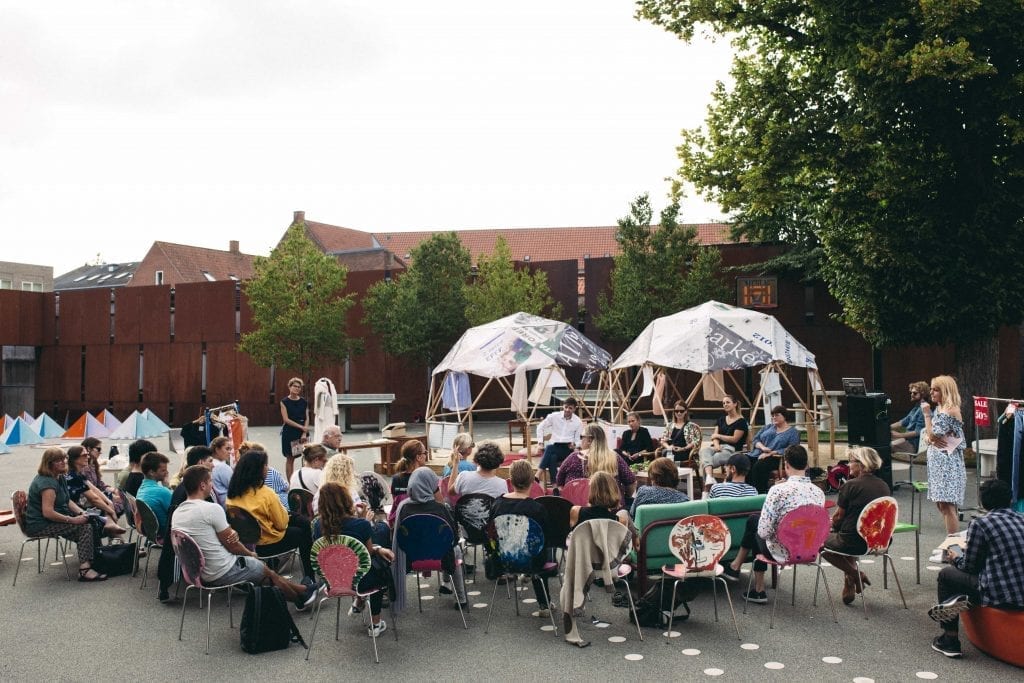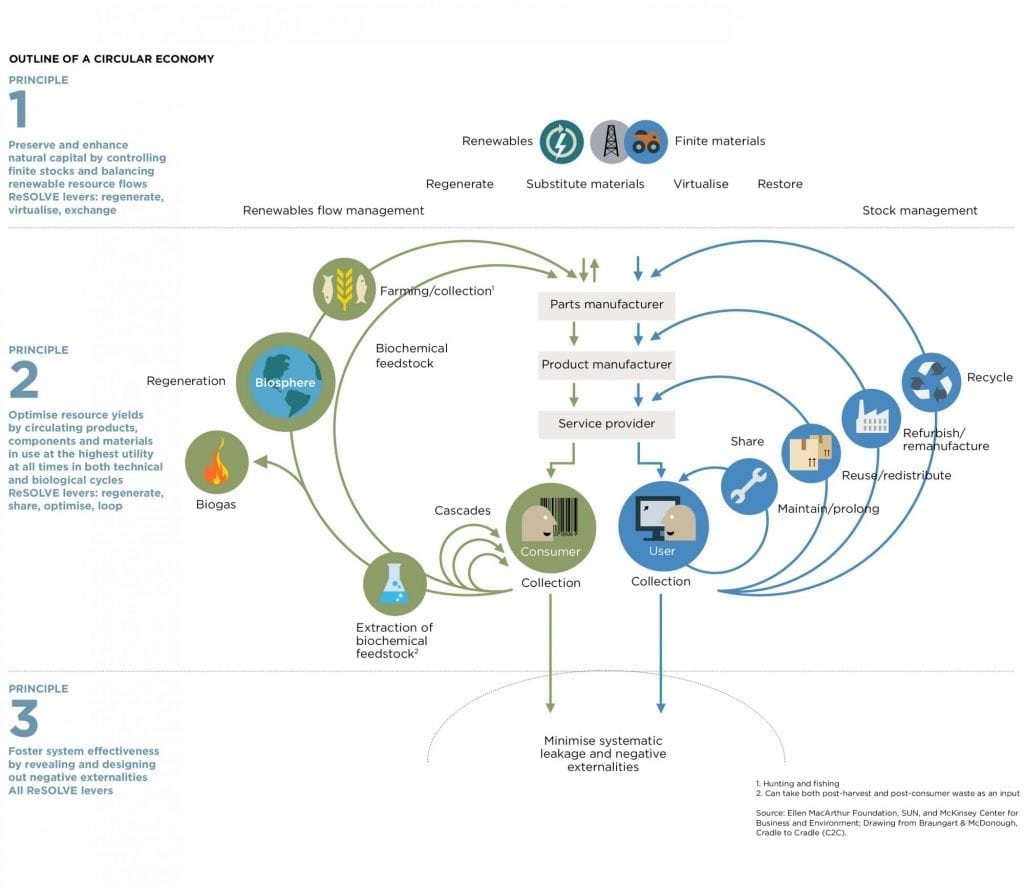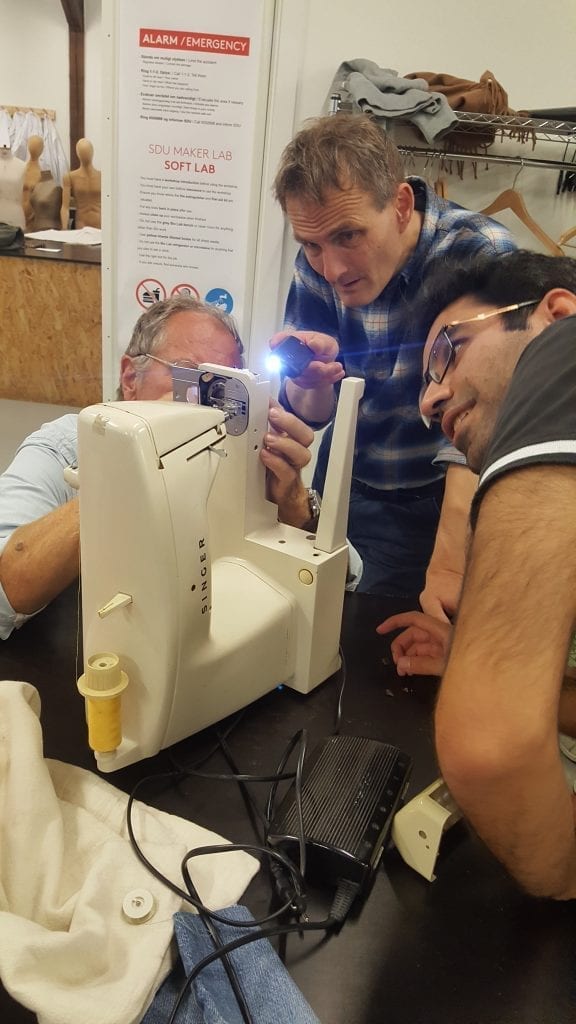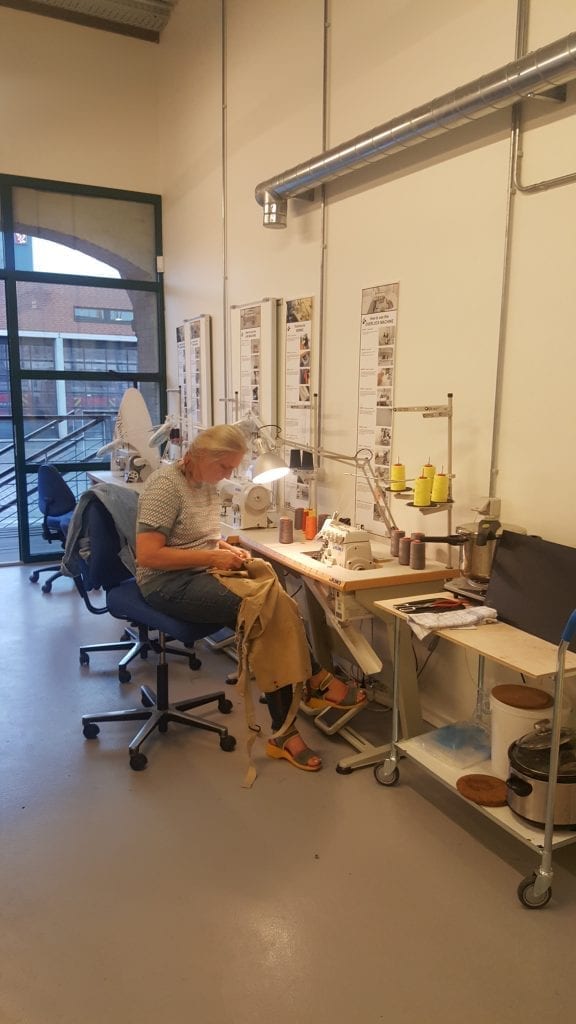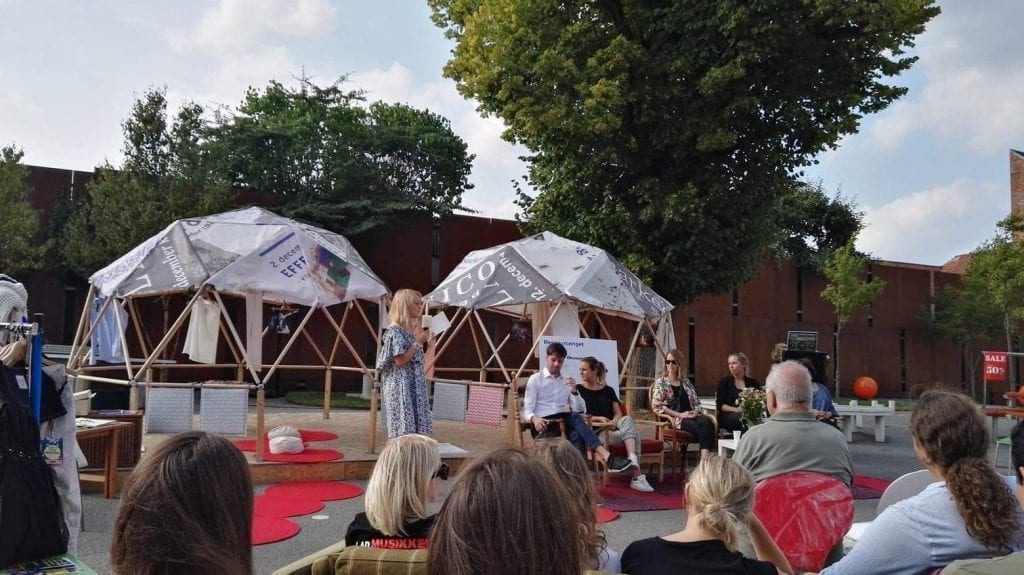How can we begin eco-friendly by following the principles of the circular economy?
Let’s start with what is “Circular Economic”?
Let us start with the fact that this is not just a modern trend, momentum or a phenomenon – it’s a business, it’s an economy. That is it, there are also some rules – we have a market, we have players in this market, we have competitors, manufacturers, customers. And we have products. The circular economy by definition is a model which defer to the current economy called a Linear Economy. The Linear Economy presents the conventional way of organising the market and utilising the resources. Companies take a position on the market, defined by their strategy, produce specific products/services, fulfilling the demand of the consumers. The consumers use these outcomes and then when they reach the end of life are being thrown away. On one hand, because of the growing population and demand, the growing buying power and speed and on the other hand resources becoming insufficient, the Linear Economy cannot anymore provide the same sustainable living standards and growth for the economy as before (Ellen MacArthur Foundation, 2013).
A good solution appears to be the Circular Economy. By definition “a circular economy is one that is restorative by design, and which aims to keep products, components and materials at their highest utility and value, at all times.” (Webster, 2015:16). Building on McDonough and Braungart’s (2002) idea ( Cradle2Cradle), the Ellen MacArthur Foundation in partnership with the consultants from McKinsey have proposed a “butterfly model” of the Circular Economy. It can be explained by consisting of two types of material flows: biological nutrients, which are designed to re-enter the biosphere and build natural capital; and technical nutrients, which are designed to circulate in closed loops without entering the biosphere. This model is not only a design concept; it is a holistic view of a whole system thinking – maximising the use of the raw materials and creating a balance between economy, environment, and society.
But let us stop with the definitions! We were shocked by the fact that:
The population is expanding quickly, and we will need 1.7 Earths if the world´s population continue to consume with the same speed as today.
“Climate change, finite resource depletion, loss of biodiversity, water stress, conflict over energy and resources, geopolitical tensions, human rights and economic failure are the complex challenges of the 21st century.” (Walcher & Leube, 2017:1). The Circular Economy (CE) appears to be a better solution in contrast to the nowadays linear approach, induced by innovation. It looks trustworthy and reliable because people can have a good standard of living, with better quality and improved efficiency of the materials used.
Along with the huge benefits of the new economy, there are a number of ambiguities and challenges: in a collaborative system, are the entrepreneurs responsible for utilising too many resources for driving their ventures towards growth or the consumers are the ones who drive the demand towards more functional, easy to use and fast to exploit gadgets that implied a negative impact over the environment surrounding us?
With many other thoughts in our mind, we have decided to organize an event in the form of a debate, where the audience and we can ask – all that concerns us about the circular economic and future initiatives. The event happened just a few days ago, on 22nd of August “A PERFECT CIRCLE – Manifestation of a circular development” in Kolding, Denmark. We have been very active there because our CEO Svetlana Petrova is living in Denmark now.
In a collaboration with another project called The Piazza Project, our goals were to stress the importance of the debate on sustainability in a public venue, open to support the exchange of ideas and proactive dialogue. We wanted people to raise their hands and speak out loud and ask the world, the politicians, the people in the municipality and the business whatever their concerns are. The event was opened to local citizens, students, internationals: an opportunity to meet, exchange ideas and create new networks in a place, The piazza, that has been designed and displayed as an experimental, open and public meeting place, at disposal of citizens 24/7 until the end of September.

We have planed four talks, led by people belonging to different working experiences and with diverse backgrounds, which opened the event presenting ongoing projects and goals for the coming years: the leitmotif of the talks explained the need for raising the awareness and changing daily habits in order to reduce the waste and to inspire smarter choices of consumption.
The Speakers
Our first speaker was Stella Jensen, who is a Project Manager of the Circular Economy program in the Municipality of Kolding. She presented the concept of circular economy and why Kolding has chosen to make it part of their city strategy. Furthermore, she told about the current initiatives already implemented, and the future plans which the municipality have set for the adoption of the principles of the Circular Economy.
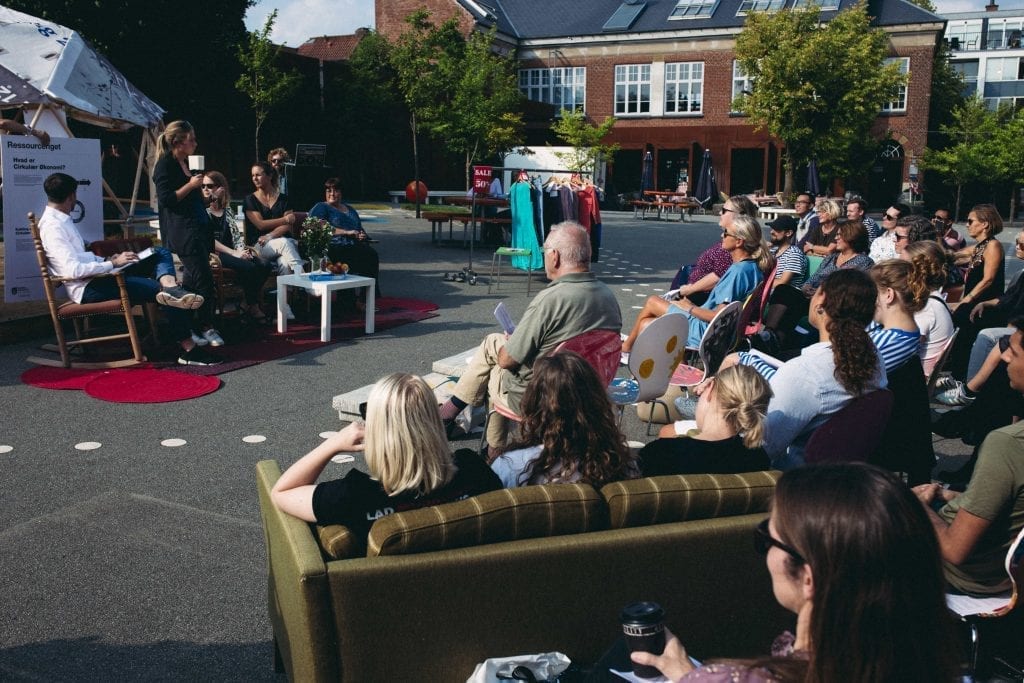
Then Tina Klemmensen took a turn. She is a founder of the Repair Cafe in Kolding. She is interested in creating, restoring and not at least upcycle both furniture and items. These are also the main reason for the establishment of Repair Cafe in Kolding, where the growing number of volunteers with different expertise and skills are ready to help people with their broken items. You can follow all the upcoming events on their Facebook.
The third speaker Mie Schmidt presented her personal project. We had another article about her here, but this time we were more interested in the reaction of the people when hearing her. Mie Schmidt is having a year without shopping. Why? To prove to herself and her surroundings that shopping uncontrollably is not the way to happiness or a sustainable life. She explained how each of us can go through a year without shopping and why we owe it to ourselves. With only 4 months left of her year without shopping, Mie Schmidt shared about everything she has learned through the past 8 months. A good example is the amount of money she had spent on clothes in 2017, which now she invested in a great party for her birthday (ordered a food truck) 🙂

Our final speaker was Valentina Volpe, who works as a buyer at Trademark Textiles – a private label manufacturer of socks, underwear, swimwear, canvas shoes, flip flops, textile printing and accessories. Her work consists in taking care of the production of the goods, making sure about the quality level and the delivery process. There was an intriguing discussion of how businesses can guarantee fair salaries for their workers in China for examples. An interesting fact Valentina shared was that more and more customers are requesting for recycled products and packaging, more and more small and medium-sized businesses are showing they are not only excited about this topic but are also trying to shape their production into a greener one.
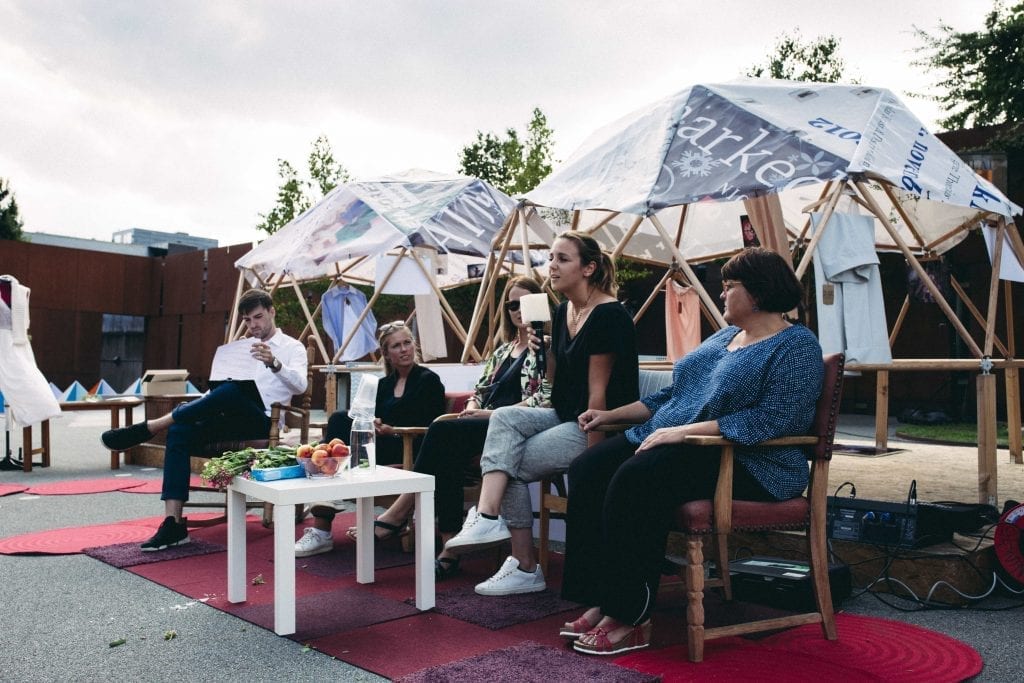
The talks stimulated a dialogue facilitated by Giovanni Dal Zilio, (entrepreneur & co-founder of the design agency Ny Dansk Bølge IVS ) between the speakers and the audience, used to put in contact with professionals and citizens, as well as it enhanced a free exchange of ideas and created an open environment where different points of view have been expressed.


The Exhibition
The cherry on the cake was ЗОВВ COLLECTION, rather its new presentation. The pop-up exhibition focusing on the exemplary case of the upcycled collection, designed by Empty your Wardrobe in collaboration with the designer Melinda Hubin, has displayed samples of sustainable fashion production. Few pieces were represented a part of a circular flow of the textiles. It illustrated the circular business model of EYW, which aims to reduce the negative impact of the textile waste on our environment.
The exhibition, developed by an international team of fashion stylists, students, and young entrepreneurs, was for the first time presented in Kolding, after the launch of the collection in September 2017 in Sofia (Bulgaria).


You can follow us on our Facebook page Empty Your Wardrobe for more updates, as well on our Instagram account. Just we will mention that we have some ongoing “secret” projects happening now in Sofia and Berlin… 🙂
Instagram Empty Your Wardrobe
Instagram has returned invalid data.